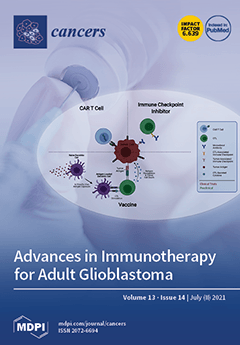EGFR mutation analysis in non-small-cell lung cancer (NSCLC) patients is currently standard-of-care. We determined the uptake of
EGFR testing, test results and survival of
EGFR-mutant NSCLC patients in the Netherlands, with the overall objective to characterize the landscape of clinically actionable
EGFR
[...] Read more.
EGFR mutation analysis in non-small-cell lung cancer (NSCLC) patients is currently standard-of-care. We determined the uptake of
EGFR testing, test results and survival of
EGFR-mutant NSCLC patients in the Netherlands, with the overall objective to characterize the landscape of clinically actionable
EGFR mutations and determine the role and clinical relevance of uncommon and composite
EGFR mutations. Non-squamous NSCLC patients diagnosed in 2013, 2015 and 2017 were identified in the Netherlands Cancer Registry (NCR) and matched to the Dutch Pathology Registry (PALGA). Overall, 10,254 patients were included. Between 2013–2017, the uptake of
EGFR testing gradually increased from 72.7% to 80.9% (
p < 0.001). Multi-gene testing via next-generation sequencing (increased from 7.8% to 78.7% (
p < 0.001), but did not affect the number of detected
EGFR mutations (
n = 925; 11.7%; 95% confidence interval (CI), 11.0–12.4) nor the distribution of variants. For patients treated with first-line EGFR inhibitors (
n = 651), exon 19 deletions were associated with longer OS than L858R (HR 1.58; 95% CI, 1.30–1.92;
p < 0.001) or uncommon, actionable variants (HR 2.13; 95% CI, 1.60–2.84;
p < 0.001). Interestingly, OS for patients with L858R was similar to those with uncommon, actionable variants (HR 1.31; 95% CI, 0.98–1.75;
p = 0.069). Our analysis indicates that grouping exon 19 deletions and L858R into one class of ‘common’
EGFR mutations in a clinical trial may mask the true activity of an EGFR inhibitor towards specific mutations.
Full article






